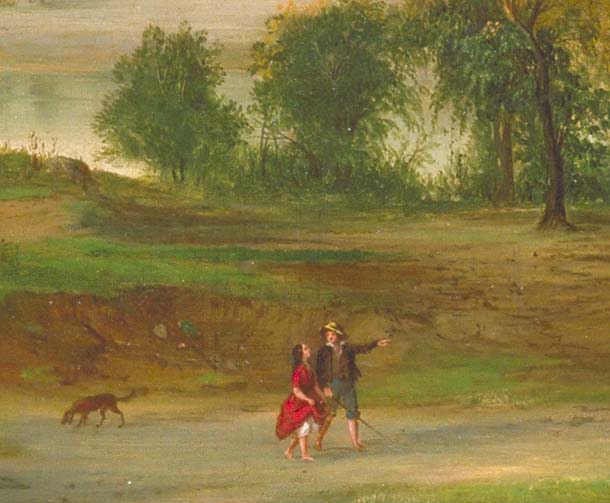Robert Seldon Duncanson
"English landscapes were better than any in Europe, and the English are great in water color while the French are better historical painters than the English. I am disgusted with our Artists in Europe. They are mean Copiests. My trip to Europe has to some extent enabled me to judge of my own talent. Of all the landscapes I saw in Europe (and I saw thousands) I do not feel discouraged." — Robert Scott Duncanson in Letter from Duncanson to Junius R. Sloan, 22 Jan. 1854. Platt R. Spencer Collection, Newberry Library, Chicago, Ill.
Robert Scott Duncanson was perhaps the most accomplished African-American painter in the United States from 1850 to 1860. He was born in Seneca County, New York, in 1821 to an African-American mother and Scottish-Canadian father, who sent his son to Canadian schools during his youth. In 1841 Duncanson and his mother moved to Mt. Healthy, Ohio, near Cincinnati. Little else is known about Duncanson's early life except that his second wife Phoebe was biracial, and the couple's only child, a son Mittie, was born in Cincinnati.
It is not known when or where Duncanson received his early artistic training, but by 1842 he had begun exhibiting in Cincinnati. In 1853 Duncanson made his first European trip, which was apparently financed by an abolitionist organization from Ohio. He visited England, France, and Italy, and may have traveled to Germany. In England, Duncanson was especially attracted to the landscapes of Claude Lorrain and J. M. W. Turner. Duncanson's trip to Europe probably did not last longer than a year as he returned to Cincinnati in 1854 and became the proprietor of a photography studio. But by the following year he had switched from photography to painting full time.
Duncanson's paintings may be divided into five categories: portraits, regional landscapes, landscapes inspired by literature, still lifes, and murals. The largest and most important commission in Duncanson's career was a series of murals he painted for abolitionist and political leader Nicholas Longworth between 1848 and 1850 for the main entrance of Belmont, his residence in Cincinnati. The Belmont murals consist of four over-door compositions and eight large landscape paintings executed in a trompe l'oeil style. Each panel is more than six by nine feet, and are the largest paintings among Duncanson's works.
Sometime in 1849 Duncanson established a studio in Detroit where he had been active as early as 1846. His artistic activities were favorably noted in both Cincinnati and Detroit where he worked throughout his career. Duncanson was also at one time associated with the prominent African-American photographer J. P. Ball in Cincinnati. Ball employed Duncanson to execute finished oil paintings from daguerreotypes.
Duncanson's finest paintings are the landscapes of his middle and late periods. These works define him as a Midwestern romantic, realist painter. Although he spent the greater portion of his active years in Cincinnati, he traveled widely north and west of Ohio and also to the upper ranges of the Mississippi River. In 1851 a Cincinnati patron financed his painting trip to New Hampshire and Vermont. Later William Miller, a miniaturist and friend of Duncanson, wrote that during a visit to Cincinnati, he observed that Duncanson was executing beautiful Italian landscapes from sketches he had made while traveling in Europe in 1853.
During the early 1860s Duncanson traveled north, painting and sketching in Minnesota and Vermont, and crossing into Canada. Duncanson's second trip to Europe, as well as his Canadian sojourn, were motivated by his increasing unhappiness in the United States and a supposed desire to leave. In 1861 or 1862 Duncanson went to Scotland. His name is not listed in the Cincinnati or Detroit city directories from 1864 to 1866, and it is likely that he wished to leave the United States during the Civil War.
By 1867 Duncanson had returned to this country and began exhibiting works directly inspired by his European travels. He made a final trip to Scotland in the years 1870 to 1871, and completed a number of paintings during his stay. Back in the United States by the summer of 1871, Duncanson exhibited his Scottish paintings with remarkable success. By all indications Duncanson's career was flourishing, and his paintings commanded up to five hundred dollars each, a very high sum for the time.
Unfortunately, when his career seemed brightest, he succumbed to emotional illness. His mental collapse occurred during the summer of 1872 while the artist was arranging an exhibition of his works in Detroit. He was hospitalized for three months at the Michigan State Retreat, and on December 21, 1872, he died. Duncanson's obituary in The Detroit Tribune of December 29, 1872, stated that, "He had acquired the idea that in all his artistic efforts he was aided by the spirits of the great masters." The problems of a biracial person in pre- and post-Civil War America, as well as his concern for his status as an artist, may have contributed to Duncanson's breakdown. So too may have Duncanson's seemingly irreconcilable conflicts between the romantic and realistic tendencies in his paintings. Perhaps it was the romantic realm in which Duncanson sought to escape from the harsh realities of prejudice.
Regenia A. Perry Free within Ourselves: African-American Artists in the Collection of the National Museum of American Art (Washington, D.C.: National Museum of American Art in Association with Pomegranate Art Books, 1992)


























